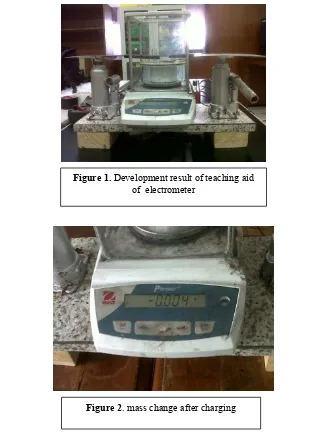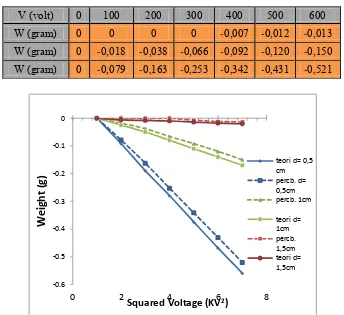Proceeding of International Conference On Research, Implementation And Education Of Mathematics And Sciences 2014, Yogyakarta State University, 18-20 May 2014
PE-45
DEVELOPMENT OF TEACHING AID OF ELECTROMETER
IN PHYSICS LEARNING
Dr. Esmar Budi, M.Si, Hadi Nasbey, S.Pd, M.Si, and Dio Sudiarto
Physics Department, Faculty of Mathematic and Science State University of Jakarta
ABSTRACT
The aim of this research is to develop teaching aid of electrometer based on Coulomb’s law for twelfth grade of Senior high school and university students studying on fundamental physics. This research is done on december 2013 at laboratory of physics education, State University of Jakarta. The teaching aid of electrometer was demonstrated in physics learning to fifteen university students participating as test object. Method used in this research is research and development. Result of need analysis shows that development of teaching aid of electrometer is needed in physics learning. Teaching aid of electrometer is teaching aid used to help students understanding Coulomb’s law. Teachers doing experiment, lecturers teaching fundamental physics, and university students doing research about coulomb’s law can use the teaching aid of electrometer. The teaching aid is validated by media and concept experts in Likert scale. Result of validation given by concept and media experts and result of field test by university students assert that the teaching aid of electrometer is very good and interpretation scores are 85% from concept experts, 88% from media experts, and 84% from field test. Based on the data, it is concluded that teaching aid of electrometer can help physics learning in understanding Coulomb’s law.
Key words: development of teaching aid, Coulomb’s law, learning media
INTRODUCTION
In physics learning, teaching aid is needed to help students observe natural phenomena. Static electricity is one of topics that need teaching aid in learning process because it is an abstract topic. Besides that, based on observation about how students learn physics, many students calculate more than make observation. Whereas, technology that we use today need observation to help scientists to develop technology. Coulomb’s law discussing aboung charged bodies is part of static electricity topic. It is also an abstract topic that had been learnt since junior school. In this topic, teaching aid is needed to help students to understand the topic well. Unfortunately, many teachers give a lot of lectures without any demonstration, so students usually calculate by applying formulas given by teacher from textbook. Other teachers teach this topic by using power point as media learning because they do not have teaching aid to do
demonstration on Coulomb’s law topic. This condition makes students have difficulties to understand the topic. Teaching aid is very usefull to demonstrate Coulomb’s law. Therefore,
research about electrometer as teaching aid to help students understand Coulomb’s law is has to be done.
Electrometer used in this research is focused on Coulomb’s law.
METHOD
The method used in this research is research and development. It is a kind of research method used to create product and test product efectiveness. According to Sugiyono (2011), some steps that can be done to create product and test product efectiveness are: Potential and
E. Budi, H. Nasbey, D. Sudiarto / Development of Teaching … ISBN 978 – 979 – 99314 – 8 – 1
PE-46
Figure 1. Development result of teaching aid of electrometer
Figure 2. mass change after charging
problems, data collecting, product designing, design validation, design revising, product testing, product revising, field test, and mass producing.
RESULT AND DISCUSSION
Teaching aid of electrometer is a measurement device for electric potential, but in this research teaching aid of electrometer was developed to demonstrate and calculate Coulomb’s law. By using concept of parallel-plate capasitor, this teaching aid of electrometer can tell us
Proceeding of International Conference On Research, Implementation And Education Of Mathematics And Sciences 2014, Yogyakarta State University, 18-20 May 2014
Experiment 1, plate diameter = 14,5 cm
Figure 3. experiment graph on 3 variation of distance (d) voltage from 0 to 600 volt by using plate with 11 cm of diameter
Experiment 2, plate diameter = 11 cm
E. Budi, H. Nasbey, D. Sudiarto / Development of Teaching … ISBN 978 – 979 – 99314 – 8 – 1
Figure 4. experiment graph on 3 variation of distance (d) voltage from 0 to 600 volt by using plate with 14,5 cm of diameter
CONCLUSSION
According to the result, conclussion for this research is that teaching aid of electrometer is proper and can be used as teaching aid in physics learning.
Recommendation for other researchers are: (1) teaching aid support must be equilibrium, (2) to create cover for the teaching aid, (3) to try more variation for plate diameter and distance between plates, (4) to revise regularly when the teaching aid is created massively, (5) to make mannual book for the teahing aid.
REFERENCE
Haliday, D., & Resnick, R. (1988). Fisika. Jakarta: Erlangga.
Hamalik, Oemar. (2012). Kurikulum dan Pembelajaran. Jakarta: Bumi Aksara. Prayitno. (2009). Dasar Teori dan Praksis Pendidikan. Jakarta: Grasindo.
S Straulino, A Cartacci (2009). An absolute electrometer for the physics laboratory. Italia: G Sansone
Sagala, Syaiful. (2006). Konsep dan Makna Pembelajaran. Bandung: Alfabeta. Sudjana, Nana. (2002). Dasar-Dasar Proses Belajar Mengajar . Bandung: Sinar Baru Algensindo.
Sugiyono. (2010). Metode Penelitian Kuantitatif Kualitatif dan R&D. Bandung: Alfabeta. Rohayati, Ade. (n.d.). Universitas Pendidikan Indonesia .Diakses April 2, 2013,


